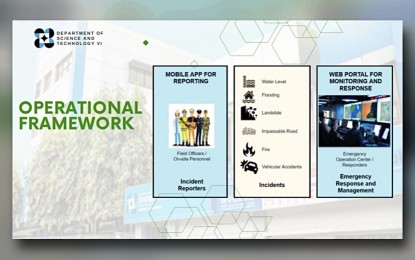
PROJECT SIGNAL. Local government units in Western Visayas are encouraged to adopt the Strategic Incident Geo-referencing for Nationwide Alertness (SIGNAL) project for real-time reporting of hazards and emergencies. Data showed only 42 LGUs in the region actively use the platform in their emergency operations centers (EOCs). (Photo screen grab from DOST report)
ILOILO CITY – Local government units (LGUs) in Western Visayas are being encouraged to adopt the communication platform for real-time reporting of hazards and emergencies developed by the Department of Science and Technology (DOST) in Western Visayas (DOST-6).
The Strategic Incident Geo-referencing for Nationwide Alertness (SIGNAL) project was piloted at the Office of the Civil Defense (OCD) and the Philippine National Police (PNP) in the early part of 2022.
It has a mobile application for reporting and a web portal for emergency response management.
The real-time reporting is expected to elicit appropriate responses from concerned government agencies and LGUs involved in disaster risk reduction and management (DRRM).
OCD regional director and chairperson of the Western Visayas Regional Disaster Risk Reduction and Management Office (RDRRMC) Raul Fernandez said the council already issued a resolution encouraging all LGUs to adopt and utilize Project SIGNAL but are, however, facing challenges in terms of how to operate the platform and internet connectivity.
Data from the DOST showed that only 42 LGUs in the region actively use the platform in their emergency operations centers (EOCs).
“We will request from DOST another batch of training for our EOCs and LDRRM officers,” Fernandez said in an interview on Friday.
He said that in 2022, all LGUs had already activated their accounts, but they did not know how to use them.
To address the lack of internet connection, he said LGUs could utilize their respective DDRM funds to invest in Starlink for faster bandwidth.
Fernandez added they are also proposing an enhancement on the platform to align it with the situation report (SITREP) of the RDRRMC for it to be adopted by the national DRRM EOC.
Fernandez said he would also propose some fine-tuning in the categories of incidents, particularly on medical emergencies, since a closer look at the details showed it catered mostly to conveyance services of patients.
DOST data showed that through the platform, there were 4,876 incidents reported from Jan. 1 to May 22 this year, of which 2, 636 were medical emergencies, 1,191 vehicular accidents, and 675 trauma reports.
“However, it can already capture other aspects, like reporting on a landslide and flooding, and we can take appropriate action because it is real-time reporting,” he added. (PNA)
